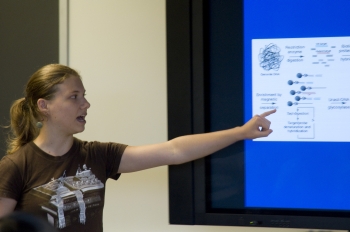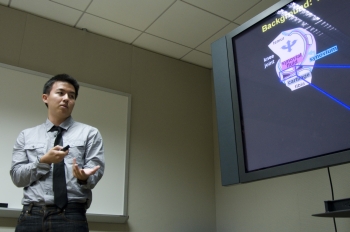Summer Scholars Bioengineer the Future
|
San Diego, CA, September 22, 2008 -- This year's class of the UCSD division of Calit2 Summer Scholars has several bioengineering majors. They may all work in the same discipline, but their projects could not be more diverse. Their depth and breadth is reflected in the subjects investigated: genomic mutations, cytokines, systems biology, hypoglycemia, soft mechanical actuators and image processing methods for cartilage tissue. This is a closer look a some of these bioengineering projects
Quantifying Random Genomic Mutations
"My project consisted of setting up an assay to quantify random genetic mutations in a specific type of cancer, chronic lymphocytic leukemia (CLL)," says Anna Freed, "There has been a debate in the scientific community about whether a higher rate of mutations was a cause or a consequence of the disease. However, until recently, no good assays existed that could quantify mutation frequency."
"The assay is complicated (it takes three days of approximately eight hours of work each day)," she continues, "And there is plenty of room for problems to occur in each step. I´ve set up a way to monitor each step of my assay, so I know exactly where my problems are occurring, and why."
|
"Anna's project went quite well," states Brad Messmer, her advisor, "I had given her a very challenging and ambitious project that involved using a very complicated molecular biology assay design from the literature that I had not personally executed in the lab. She took on this challenge and encountered many unexpected problems, as is often the case when working from literature protocols only. She resolved most of the technical aspects, but unfortunately we didn´t get as far as we had hoped." Messmer is a project scientist at the UCSD Moores Cancer Center.
"This summer gave me an opportunity to learn not only new techniques, but also how to run a project independently," she notes. Freed begins her junior year later this week. The plan is for Freed to continue the work during the school year, and she anticipates having the assay set up soon. Freed begins here junior year this week.
"Anna will continue working on the project during the school year and hopefully next summer, with the goal of presenting an abstract at the next American Association for Cancer Research meeting in April followed by a publication," explains Messmer, "I may also ultimately submit a grant proposal that incorporates her work. Anna is a pleasure to work with and I think our entire group benefits from having her around."
|
Determining the Size Distribution of Hyaluronan
Brian Lao's project was to gain a better understanding of how cytokines regulate the molecular weight of the synovial fluid lubricant molecule, hyaluronan, and to investigate the relationship between hyaluronan's molecular weight and lubricating function. This information will aid in bioengineering functional synovial fluid in bioreactors.
"With the support of Calit2, Brian was able to take on the challenge of developing an image processing program to extract out important information that allowed us to relate molecular structure to biotransport properties and biomechanical function," says Robert Sah, Lao's advisor, "While Brian had a considerable amount of prior research experience, the summer project allowed him to experience an information technology component that broadened his background considerably." Sah is a professor of bioengineering.
A bulk of Lao's time was spent in creating a MATLAB program that automated the analysis of results from the experiments he and his mentor ran to determine how cytokines affected hyaluronan molecular weight. "Since I didn't have any previous MATLAB programming experience, I really had to dive into unknown waters to be able to finish my program," recalls Lao, "I am thankful for that, as I feel more comfortable now with tackling academic endeavors that aren't so familiar to me."
Sah's graduate student, Megan Blewis has worked closely with Brian for a couple of years, she will be graduating with her Ph.D. soon. "Megan was helpful and great as always," notes Lao, "The project went very well. The experiments we ran achieved what we wanted and showed us how different cytokines affected hyaluronan molecular weight. The MATLAB program I wrote will be used to analyze the results, and all of this combined has culminated in a paper which will hopefully be published soon." Lao begins his junior year this week.
|
Remote Assistance for Hypoglycemia
Sylvia Hon's summer research project was on Remote Assistance for Hypoglycemia, the purpose of which was to create policies and/or recommendations that may help telemedicine research and the industry in terms of improving the lives of Type I diabetics.
"Sylvia's work has all the key ingredients of a great bioengineering project," says her advisor, David Gough, "application of cutting-edge technologies, focus on a significant medical problem leading to solutions that can potentially have a clear benefit to society, integration of multidisciplinary perspectives including ties to industry, and, yes, fun. Sylvia did a wonderful job!" Gough is a professor of bioengineering.
Hon did extensive literature research, looking through a selection of glucose monitoring devices, getting herself familiar with a few of the modern technologies used, such as the iPhone, and reading through an active diabetes forum. She was investigating the versatile dynamics of hypoglycemia and how it can affect individuals differently.
Her goal was to identify specifications for an alarm device that can be tailored to each individual's needs, so the device can warn the hypoglycemic individual before his or her glucose level falls below a certain threshold.
"What I most enjoyed was meeting weekly with my advisor to talk to him about my findings and my thoughts on different topics about diabetes," notes Hon, "He gave me a lot of good suggestions and good ideas."
Hon also learned about giving presentations and gained self confidence. "At first, I was afraid of presenting in front of my advisor's lab meeting group," explains Hon, "But through this experience, I was able to receive great feedback and professional opinions that can help me in my research." Hon begins her senior year shortly.
|
Advances to the BiGG Database
The Biochemical, Genetic and Genomic (BiGG) database is a widely used resource for sharing genome scale metabolic reconstructions. Jun Young Park's project with advisor Bernhard Palsson, a professor of bioengineering, developed new features which enhanced the functionality of this database.
Park added several requested features and improved the user interface. In addition to information on reactions and metabolites that was previously available, users can now look at metabolic maps and visualize how each reaction or metabolite acts within the reconstructions. "This graphical representation provides the users with another way of understanding chemical pathways," says Park,who will begin his sophomore year this week.
"I also added information about upper and lower flux bounds to exported models of the reconstructions in SBML (Systems Biology Markup Language) format," explains Park, "Which can be customized easily on the Web. Specifying the bounds of exchange fluxes is for modeling the environment, which is crucial to meaningful simulations." With the newly included features, the BiGG database is an even more valuable tool, especially for systems biology researchers.
"I enjoyed this summer because I love gaining new knowledge. I got to know a new field of science, systems biology, and I also realized that there is still much to learn," notes Park, "I would like to thank Dr. Palsson and Jan Schellenberger for helping me with difficulties I had working on the project." Schellenberger is a graduate student in Palsson's Systems Biology Research Group.
|
Soft Mechanical Actuators
Han Liang Lim's project was "Soft Mechanical Actuators: Applications in artificial implants, biomimicking devices, and stem cell culture for soft mechanical actuators." His project focused on the development of a multifunctional oscillating hydrogel device that could undergo reversible, time dependent and sinusoidal volume/mechanical changes in response to electrical field.
"Han's project went very well," notes his advisor, Shyni Varghese, "He was able to create a soft gel-based mechanical actuator that can simultaneously control the electric and mechanical properties of materials, an artificial muscle." Varghese is a professor of bioengineering.
The goal is for these oscillating hydrogels to be employed in regulating musculoskeletal differentiation of stem cells in the context of regenerative medicine.
Related Links





